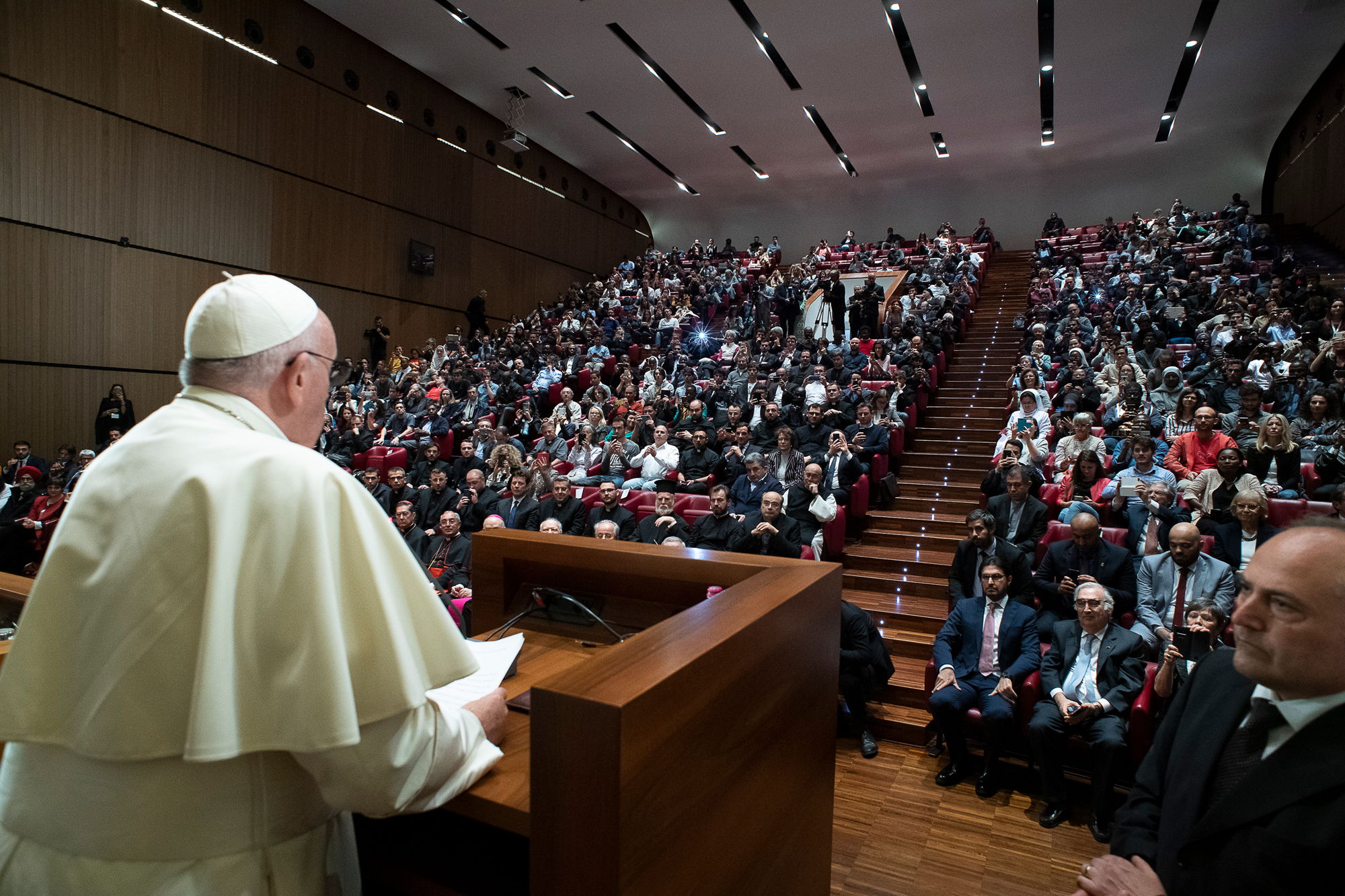The Holy Father Francis invited to “pray without ceasing and to do everything possible so that, through a true Global Educational Pact, we can inaugurate an era of peace for the whole human family.”

SS Francesco
On Thursday afternoon, October 31, 2019, the Pope went to the Pontifical Lateran University, where he opened artist Othman Alkhuzaiem’s Exhibition “Calligraphy for Dialogue: Promote the Culture of Peace through Culture and Art.”
It is an Exhibition dedicated to the memory of Cardinal Jean-Louis Tauran, former President of the Pontifical Council for Inter-Religious Dialogue.
After the opening ceremony, Pope Francis met in the “Benedict XVI” Aula Magna with the participants in the Study Day on the topic “Education, Human Rights, Peace: Instruments of International Action and the Role of Religions,” which was held in preparation for the event “Rebuild the Global Educational Pact,” which will take place on May 14, 2020.
Educate for Peace

SS Francesco
During his address, the Pontiff pointed out that to educate for peace “requires giving relief and an answer to those that are condemned to die or are obliged to abandon their affections, their homes, their native countries because of conflicts and wars,” reported “Vatican News.”
In this connection, Pope Francis said that we cannot remain indifferent, limiting ourselves to invoking peace, but that all of us, educators and students, “are called to build and protect peace every day, addressing our prayer to God so that He will grant it to us.”
Educational Pact

SS Francesco
In regard to the subjects of peace, human dignity, inclusion and social participation, the Bishop of Rome stressed that these make patent the need for a broad educational pact “able to transmit not only knowledge of the technical contents but also and above all, human and spiritual wisdom, made up of justice, rectitude, and virtuous behavior, capable of being realized in practice.”
Moreover, he questioned the many times that the youngest are excluded, because the objectives proposed are not really attainable or because they are designed only to satisfy limited interests.
“Instead of conditioning the future path of the youngest generations, we should transmit to them a method capable of valuing an experience, including a negative one. A method capable of looking at the events in their causes and to provide the tools to overcome conflicts and oppositions.”
Recourse to Dialogue

SS Francesco
Given the lack of peace in different parts of the world, the Holy Father says that “it’s not enough to invoke freedom from war, to proclaim rights and even use authority in its different forms,” but it is necessary “to question and recover the capacity to be among persons, to dialogue with them, and to understand their needs, perhaps with our weakness, which is the most authentic way to be received when we speak of peace,” reported “Vatican News.”
Educate in Dialogue

SS Francesco
Through dialogue, an effort is made to prevent and resolve conflicts, but also “to make manifest the values and virtues that God has written in the heart of every man and that is manifested in the order of creation,” continued the Pope.
“To seek and explore every opportunity for dialogue is not only a way of living or coexisting but rather a good educational criterion,” he added.
Therefore, the Pope exhorted those present to go “forward with courage,” as “we need men of faith and of goodwill that educate to true dialogue, using all possibilities and occasions.”
Cardinal Tauran’s Three Dialogues

SS Francesco
The Holy Father referred to Cardinal Jean-Louis Tauran’s trajectory, highlighting that “his life was projected in the perspective of dialogue. In the first place, dialogue with God, which Christian, priest and Bishop Tauran cultivated, which inspired options and actions and in which he found consolation during his illness.”
In the second place, “the dialogue between peoples, governments and international institutions for which diplomat Tauran worked to promote the conclusion of agreements, mediation or to propose solutions, including technical solutions, to the conflicts that undermine peace, limit human rights and darken freedom of conscience.”
Finally, the third, “is dialogue between religions, which the Cardinal cultivated not to reaffirm existing points in common, but to look for and build others,” said Pope Francis, adding that the Cardinal demonstrated that “it’s not enough to stay in what brings us closer, but it’s necessary to explore new possibilities so that the different religious traditions can transmit — in addition to a message of peace –, peace as message.
“Calligraphy for Dialogue”

SS Francesco
According to the French edition of Vatican Radio, the exhibition “Calligraphy for Dialogue: Promote the Culture of Peace through Culture and Art,” Saudi artist Othman Alkhuzaiem, presents “calligraphic Arabic letters on a multi-colored background.”
The letters don’t form a particular word, because “much more than an art of writing, calligraphy is a means of expression, communication, and representation, according to contemporary Iraqi calligrapher Ghani Alani, explained the same source.
The Exhibition aims at being a “bridge between cultures.” Alkhuzaiem suggests “a dialogue beyond dialogue itself, beyond the meaning of the word,” explained Marco Cardinali, the Exhibition’s Curator.
The works selected, exhibited for the first time, were created this year
With Anita Bourdin
Translation by Virginia M. Forrester



